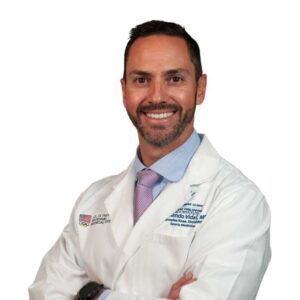What is anterior shoulder instability?
The shoulder is at constant risk of being unstable because of its ability to move, rotate, lift and turn. Sudden injuries and recurrent shoulder dislocations can make the shoulder unstable. Anterior shoulder instability occurs when the soft tissue of a shoulder allows the humeral head to sublux (separate) or dislocate from the glenoid fossa. Anterior shoulder dislocations are more common than posterior dislocations and occur when an outstretched arm is hit forcefully as in a serious fall, or football tackle. The ball of the humerus is pulled from its position, causing the joint surfaces to no longer touch each other. Dr. Armando Vidal, Orthopedic Shoulder Surgeon serving patients in Vail, Aspen and the surrounding Denver, Colorado communities has extensive experience in treating shoulder instability.

What is shoulder instability repair?
In most cases of shoulder instability, the labrum is torn and the joint capsule/ligaments are stretched. Surgical shoulder instability repair is used to repair the labrum and tighten the joint capsule and the ligaments within the joint. This allows the ligaments to stabilize the shoulder and prevent recurrent dislocations.
What causes a shoulder instability repair to fail?
Although stabilization procedures successfully reduce the risk of shoulder dislocation recurrence, the procedure is not without complications. Studies show more than 80% of shoulder instability repair failures are due to bone loss. Other causes of shoulder instability repair failure are:
- Failed labral repair
- New trauma
- Improper healing of the labrum and/or ligaments
- Early return to sports
- Improper physical therapy
- Failure of bone graft
How is a revision shoulder instability surgery performed?
Before proceeding with revision surgery, it is imperative that Dr. Vidal do a thorough evaluation to determine the exact nature of the patient’s shoulder instability. The nature of the recurrences, prognosis and a realistic set of expectations are important for the success of a revision shoulder instability surgery. Dr. Vidal will take into consideration the condition of the labrum, capsule, and surrounding tissues before proceeding with any revision surgery.
Once it has been determined that revision shoulder instability surgery is required, Dr. Vidal may use one or more of the following surgical techniques:
Arthroscopic Revision Surgery – Modern minimally invasive techniques have improved the success of stabilization procedures making arthroscopic revision surgery a viable revision procedure in the case of recurrent instability. The goal is to re-tighten the lost tissues and ligaments that have re-stretched or were not corrected appropriately with the first procedure. Success rates have been reported as high as 90%. Revision Bankart repair, done arthroscopically, is more complicated as a result of prior stabilization procedures making this a highly technical procedure that should be attempted only by a highly skilled surgeon like Dr. Armando Vidal.
Open Revision Bankart Repair – Open surgery utilizes a larger incision on the shoulder than arthroscopic surgery. The open technique allows Dr. Vidal to better visualize the labrum and make necessary repairs. Open revision Bankart repair has been shown to be successful for both collision and contact athletes, returning them to sport activities following a failed primary procedure.
Latarjet Procedure – The size and amount of bone loss or defect plays a major role in determining the best procedure in managing shoulder instability with the Latarjet procedure. During this specialized procedure, Dr. Vidal uses the coracoid (a small bump of bone on the front of the scapula) as a bony bumper in the Latarjet procedure. The bone graft is held in place with screws and prevents further shoulder dislocations.
Glenoid Bone Graft – In cases of bone loss where the socket of the shoulder is compromised, a glenoid bone graft may provide the needed stability by deepening the socket. The bone graft is taken from the iliac crest (top of the hip bone) and secured with screws to the front of the shoulder socket. This is a highly technical procedure and should only be performed by highly skilled surgeons such as Dr. Vidal.
Capsular Reconstruction – This is a very rare procedure and seldom needed. In this procedure an allograft (cadaver graft) is used to recreate the labrum and capsular ligaments. The graft does the job of the damaged labrum and holds the humeral head within the glenoid (shoulder socket).
Can my revision shoulder instability repair fail again?
Failure of shoulder instability repair procedure can often be related to uncorrected anatomic pathology. Dr. Vidal can recognize excessive capsular laxity or a large glenohumeral bone defect before surgery to avoid a recurrence of instability. He performs a careful history, physical examination and obtains x-rays and an MRI to evaluate each patient’s risk for failure. When treating patients who have had a previous shoulder instability treatment that has failed, he has found his emphasis on intraoperative judgement is helpful in avoiding additional recurrence of shoulder instability.
Patients must commit, preoperatively to a thorough physical therapy and strengthening program with the understanding that they may not be able to return to contact sports or high impact sports where recurrent shoulder dislocations can occur.
Shoulder Instability Surgeon
If you previously received a surgical procedure as treatment for shoulder instability, there is a chance that the procedure may fail, resulting in the instability to return. In this case, it is recommended to receive a revision surgery to eliminate the shoulder instability once again. Arthroscopic shoulder surgeon, Doctor Armando Vidal provides revision surgeries for patients in Vail, Aspen, and the surrounding Denver, Colorado communities who are experiencing recurring shoulder instability after surgery. Contact Dr. Vidal’s team today!

Locations
180 S Frontage Rd W
Vail, CO 81657
226 Lusher Court
Ste 101
Frisco, CO 80443
322 Beard Creek Road
Edwards, CO 81632


